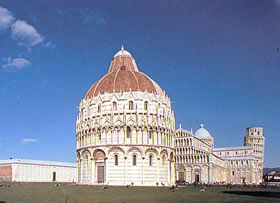Pisa - Piazza dei Miracoli

The Square of Pisa's Cathedral, commonly known as "Miracles Square" (or "Field of Miracles", called with this name because of the harmonic relationship of the several buildings located there), is in a decentralised position against the historic centre of the town.
The area, dedicated to the cult since the age of the Etruscans, represents the religious centre of the town and includes buildings made in the period between the 11th and the 14th centuries. In the square there are the S. Maria Maggiore's Cathedral (with the annexed bell-tower), the Baptistery e the Cemetery, which can be symbolically considered as the three main moments in man's life: birth (the Baptistery), life (the Cathedral), death (the Cemetery). Beside the Cathedral and the steeple tower, particularly important from the architectural point of view are the Baptistery and the Camposanto monumentale (Cemetery).
The construction of the Baptistery was started in 1152 by the architect Deotisalvi (who also made the plan of the Santo Sepolcro church in 1153) and finished only in the 14th century. The outside follows the decoration pattern of the Cathedral, characterised on the round floor by blind arcades with a series of open loggias and arches on columns on the top.
This first stage of construction ended at the end of the 12th century: works restarted around the middle of the 13th century under the supervision of Nicola Pisano who, in collaboration with his son Giovanni (who inherited the management of the building yard after his father's death in 1284), introduced the crowning with cuspidate pinnacles and tabernacles with a rayonnant style.
An epigraph inside the building reporting the year 1278 refers to the new construction of the Baptistery, even if probably the works, started a few years earlier, ended after that date.
In the gate's lunette there was a big statue of Giovanni Pisano showing a Madonna with Child (now in the Opera Museum and replaced in loco with a copy).
Inside, there are the christening font of Guido Bigarelli from Como (1246) and the pulpit of Nicola Pisano, signed and dated 1260, first certain work of the great artist, whom we owe the renewal of Italian sculpture in the Gothic age.
Il Cemetery, started in 1277 by Giovanni di Simone (as recalled in the inscription near the right gate) was completed only in the 14th century. It completes the group of religious buildings in the square, enclosing the old cemetery. Located next to the enclosing wall, the Cemetery is developed longitudinally in such a way as to ideally link the Cathedral with the Baptistery.
Inside the porticoed corridors there are several Roman sarcophagi, while some nobles of Pisa are buried under the floor. Damaged by a bombing in 1944, the Cemetery still has frescoes of Taddeo Gaddi (Stories of Giobbe, about 1342), Spinello Aretino (Stories of St.Efisio and St.Potito, 1390-91), Andrea Bonaiuti (Stories of St.Ranieri, 1377) and of the so-called "Master of Death's Triumph", identified by the critics with Buonamico Buffalmacco (Universal Judgement, Hell, Death's Triumph).
The frescoes made by Benozzo Gozzoli on the Northern wall of the Cemetery, depicting Stories form the Old Testament (1468-84) have been almost completely lost, only some fragments being preserved. However, their beautiful sinopites preserved in the neighbouring Museum of Sinopites in Pisa, can be seen.